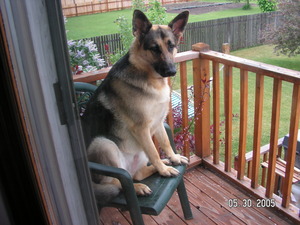Pannus, or Chronic Superficial Keratitis, is a disease commonly found in German Shepherds. It’s an autoimmune disease which slowly and progressively attacks the cornea of the eye. It causes swelling of the cornea, brown or pinkish tissue ingrowth, and blood vessel ingrowth and scarring. These corneal changes lead to a slow and progressive loss of vision and may eventually lead to blindness. This condition is seen predominately in German Shepherds, but occasionally it’s seen in other breeds as well. Symptoms commonly first appear when dogs are between the ages of four and six, but they may begin sooner. When our German Shepherd was diagnosed with this condition three years ago we were shocked and desperate for information and answers.
The cause of Pannus is not known. There are a few factors thought to be involved. Since it’s commonly seen in German Shepherd dogs, there is a heredity factor. The dog’s immune system also contributes to the severity of the disease. The dog’s body directs an inappropriate immune response against the tissues of the cornea. Ultraviolet radiation plays a role as a catalyst and can cause worsening of the condition. Dogs living at high altitudes where the UV rays are strongest seem to be more severely affected. Our dog was a sun-worshipper. She was the talk of the neighborhood because she actually used to sit in a lawn chair on our deck and soak up the sun. Living in a high altitude area of Utah we shouldn’t have been surprised when she developed Pannus.
Unfortunately there is no cure for this disease. However, it can be managed by corticosteroid treatments to help halt the problem and keep it stable. It’s best to catch the disease early on and keep your dog on a rigid treatment schedule to keep the disease from progressing.
If you suspect your dog might have Pannus take it to the vet for a diagnosis. You may notice reddish or brownish colored spots on the whites of the eyes, discharge, and/or a brown film covering the cornea. If a Pannus diagnosis is made there are several things you can do to help your dog and control the condition. The veterinarian will probably start your dog on a prescription of cyclosporine and/or corticosteroids. These are drops or ointments to put in your dog’s eyes a few times a day as prescribed. The corticosteroid (cortisone) drops and cyclosporine, when used together, are most effective against the progression of the disease. In most cases this regimen is all you will need to slow down the degenerative process and help keep your dog’s eyes comfortable and pain-free. If the Pannus is severe the vet may want to routinely give your dog corticosteroid shots below the whites of the eyes. In rare cases the vet may want to perform surgery, especially if the Pannus has reached the third eyelid.
If you are unsure about the treatments suggested, it’s okay to get a second opinion. Veterinary bills can be costly. When our dog was diagnosed with Pannus our vet wanted us to bring her in for check-ups along with buying new bottles of the steroids every month. Although we felt it was helping, it was very costly. We took her to another veterinarian who’s comfortable with us bringing her in for a check-up only twice a year unless there’s a problem. Since the cyclosporine is made in their office it only costs us 30 dollars for a month and a half supply. The corticosteroids we buy at a regular pharmacy. They cost us only 12 dollars for a month and a half supply. Changing veterinarians saved us a considerable amount of money.
Since UV rays play a huge factor in the progression of the disease, try to keep your dog out of direct sunlight as much as possible. Keep your pet indoors when the sun is hottest. If that’s not possible at least make sure it has shady places and shelters outside. Take your dog for walks in the early morning, evening, or when the sun isn’t at its brightest. There are actually sunglasses made just for dogs called Doggles. We haven’t tried these out on our dog but we’d be curious to see how they’d work.
Pannus will cause varied degrees of limited vision. Your dog may not be as active and probably won’t be able to play fetch very well anymore. You may want to limit extra food and treats. If your pet is less active it’ll be easier for it to put on extra weight. Remember to use your voice a lot, especially when approaching your pet from a distance, so it recognizes you. It’s comforting to know that German Shepherds rely on their senses of smell and hearing the most. Our dog still enjoys going on walks and running around relying on these senses. Your dog will probably enjoy playing with stuffed animals and chew toys. Our dog loves playing “roll the ball” with a tennis ball and nudges it back to us when we roll it to her.
If your dog has been diagnosed with Pannus try not to worry. If you follow the regimen advised by your veterinarian and limit sun exposure you can keep its vision loss under control. Keep loving and caring for your pet and I’m sure it will be just as happy and healthy as ours is.




